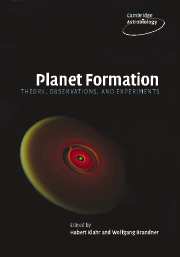Book contents
- Frontmatter
- Contents
- Preface
- Acknowledgments
- 1 Historical notes on planet formation
- 2 The Formation and Evolution of Planetary Systems: placing our Solar System in context
- 3 Destruction of protoplanetary disks by photoevaporation
- 4 Turbulence in protoplanetary accretion disks: driving mechanisms and role in planet formation
- 5 The origin of solids in the early Solar System
- 6 Experiments on planetesimal formation
- 7 Dust coagulation in protoplanetary disks
- 8 The accretion of giant planet cores
- 9 Planetary transits: a first direct vision of extrasolar planets
- 10 The core accretion–gas capture model for gas-giant planet formation
- 11 Properties of exoplanets: a Doppler study of 1330 stars
- 12 Giant-planet formation: theories meet observations
- 13 From hot Jupiters to hot Neptunes … and below
- 14 Disk–planet interaction and migration
- 15 The brown dwarf–planet relation
- 16 Exoplanet detection techniques – from astronomy to astrobiology
- 17 Overview and prospective in theory and observation of planet formation
- References
- Index
9 - Planetary transits: a first direct vision of extrasolar planets
Published online by Cambridge University Press: 14 September 2009
- Frontmatter
- Contents
- Preface
- Acknowledgments
- 1 Historical notes on planet formation
- 2 The Formation and Evolution of Planetary Systems: placing our Solar System in context
- 3 Destruction of protoplanetary disks by photoevaporation
- 4 Turbulence in protoplanetary accretion disks: driving mechanisms and role in planet formation
- 5 The origin of solids in the early Solar System
- 6 Experiments on planetesimal formation
- 7 Dust coagulation in protoplanetary disks
- 8 The accretion of giant planet cores
- 9 Planetary transits: a first direct vision of extrasolar planets
- 10 The core accretion–gas capture model for gas-giant planet formation
- 11 Properties of exoplanets: a Doppler study of 1330 stars
- 12 Giant-planet formation: theories meet observations
- 13 From hot Jupiters to hot Neptunes … and below
- 14 Disk–planet interaction and migration
- 15 The brown dwarf–planet relation
- 16 Exoplanet detection techniques – from astronomy to astrobiology
- 17 Overview and prospective in theory and observation of planet formation
- References
- Index
Summary
Introduction
The observation of a transit in our own Solar System is a long-lasting experience. Historical events related to transits can be traced back to Ptolemy who mentioned in his “Almagest” that the lack of detections of transits was not in contradiction with Mercury and Venus being closer to the Earth than the Sun (in the geocentric system) simply because they could be either too small to be detected or their orbital plane could be slightly tilted to the Solar one (Gerbaldi, personal communication). In 1607 Johannes Kepler thought he had directly observed a predicted Mercury transit but in fact only followed sun spots. He did, however, predict the next transits of Venus and Mercury to take place in 1631 following the extremely accurate observations of the planets by Tycho Brahe. The first transit to be observed was the Mercury transit in 1631 with the best observations leading Pierre Gassendi to evaluate its diameter to be less than 20 arcsec, much smaller than ever thought before. All the following transit observations led to new ephemerides and estimates of the size of the Solar System, but not as accurate as expected because of the difficulty of locating in time the entrance and exit of the planetary disk over the Solar one. First pictures of the Venus transit were made as early as in 1874 (Fig. 9.1). The transit of Mercury was also observed with the Solar and Heliospheric Observatory (SOHO) spacecraft from the L5 Lagrange point of the Earth.
- Type
- Chapter
- Information
- Planet FormationTheory, Observations, and Experiments, pp. 147 - 162Publisher: Cambridge University PressPrint publication year: 2006
- 1
- Cited by



